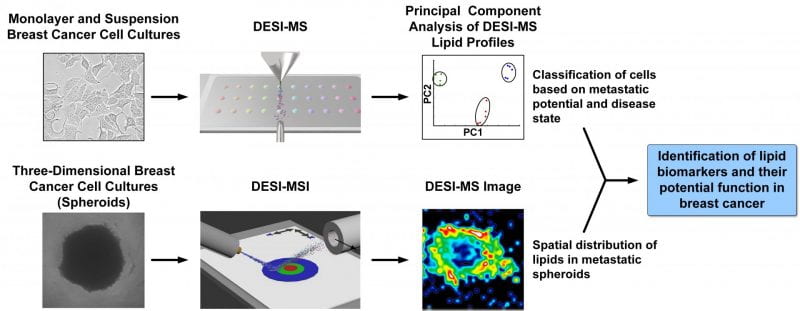Halmos Undergraduate Co-Authors an Article in a Bioanalytical Chemistry Journal

 This spring, Halmos College Biology major Elaine Ognjanovski (minors in Psychology and Experiential Leadership) co-authored a publication with Richard H. Perry, Ph.D. entitled, “Identification of lipid biomarkers of metastatic potential and gene expression (HER2/p53) in human breast cancer cell cultures using ambient mass spectrometry”, which was published in the journal Analytical and Bioanalytical Chemistry. Dr. Perry, a faculty member in the Department of Chemistry and Physics, worked with Elaine on developing a desorption electrospray ionization mass spectrometry method that enables the identification of lipid biomarkers of HER2/p53 expression, metastatic potential, and disease state in monolayer, suspension, and spheroid human breast cancer cell cultures.
This spring, Halmos College Biology major Elaine Ognjanovski (minors in Psychology and Experiential Leadership) co-authored a publication with Richard H. Perry, Ph.D. entitled, “Identification of lipid biomarkers of metastatic potential and gene expression (HER2/p53) in human breast cancer cell cultures using ambient mass spectrometry”, which was published in the journal Analytical and Bioanalytical Chemistry. Dr. Perry, a faculty member in the Department of Chemistry and Physics, worked with Elaine on developing a desorption electrospray ionization mass spectrometry method that enables the identification of lipid biomarkers of HER2/p53 expression, metastatic potential, and disease state in monolayer, suspension, and spheroid human breast cancer cell cultures.
The article’s abstract states: “In breast cancer, overexpression of human epidermal growth factor receptor 2 (HER2) correlates with overactivation of lipogenesis, mutation of tumor suppressor p53, and increased metastatic potential. The mechanisms through which lipids mediate p53, HER2, and metastatic potential are largely unknown. We have developed a desorption electrospray ionization mass spectrometry (DESI-MS) method to identify lipid biomarkers of HER2/p53 expression, metastatic potential, and disease state (viz. cancer vs. non-cancerous) in monolayer and suspension breast cancer cell cultures (metastatic potential: MCF-7, T-47D, MDA-MB-231; HER2/p53: HCC2218 (HER2+++/p53+), HCC1599 (HER2−/p53−), HCC202 (HER2++/p53−), HCC1419 (HER2+++/p53−) HCC70 (HER2−/p53+++); non-cancerous: MCF-10A). Unsupervised principal component analysis (PCA) of DESI-MS spectra enabled identification of twelve lipid biomarkers of metastatic potential and disease state, as well as ten lipids that distinguish cell lines based on HER2/p53 expression levels (> 200 lipids were identified per cell line). In addition, we developed a DESI-MS imaging (DESI-MSI) method for mapping the spatial distribution of lipids in metastatic spheroids (MDA-MB-231). Of the twelve lipids that correlate with changes in the metastatic potential of monolayer cell cultures, three were localized to the necrotic core of spheroids, indicating a potential role in promoting cancer cell survival in nutrient-deficient environments. One lipid species, which was not detected in monolayer MDA-MB-231 cultures, was spatially localized to the periphery of the spheroid, suggesting a potential role in invasion and/or proliferation. These results demonstrate that combining DESI-MS/PCA of monolayer and suspension cell cultures with DESI-MSI of spheroids is a promising approach for identifying lipid biomarkers of specific genotypes and phenotypes, as well as elucidating the potential function of these biomarkers in breast cancer.”
Citation: Heather M. Robison, Corryn E. Chini, Troy J. Comi, Seung Woo Ryu, Elaine Ognjanovski and Richard H. Perry *, Analytical and Bioanalytical Chemistry, 2020, 412, 2949–2961. DOI: https://doi.org/10.1007/s00216-020-02537-4
